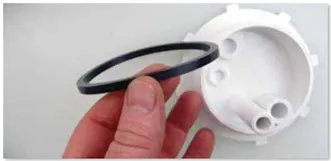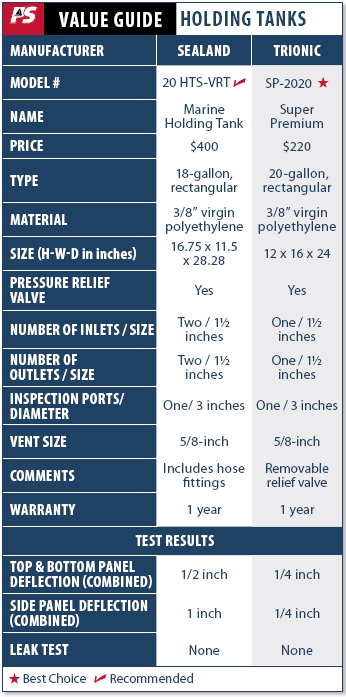
Photo by Frank Lanier
331
We recently tested an updated version of the SeaLand 20 HTS-VRT holding tank reviewed in our November 2011 test, which also featured the Trionic SP-2020 super premium holding tank. SeaLand’s tank update was adding a new, flat, square-cut O-ring for the clean-out/inspection port cap and some helpful instructions on sealing the inlet and outlet fittings. For this test, SeaLand sent us a tank with the inlet and outlet fittings firmly installed and sealed with pipe sealant, as the maker recommends. Aftermarket tanks are typically shipped with fittings separate.
The tank’s construction hadn’t changed: high-density 3/8-inch walled polyethylene, a 5/8-inch vent, 3-inch inspection port, 1½-inch inlet, and two 1½-inch discharge outlets (one for connection to a deck-mounted discharge fitting, the other for connection to an overboard discharge pump). Testers liked having the second discharge outlet as standard. The 20 HTS comes equipped with a TankSaver vacuum-relief valve, which protects the tank from implosion damage due to excessive dockside pump-out vacuum levels. The capacity of the 20 HTS was advertised as 18 gallons; however, its dimensions were a bit larger than the 20-gallon Trionic.
Results of Re-test
As in our November test, the new SeaLand tank was pressurized hydrostatically at a head pressure of 7 feet. Once pressurized, the tank was monitored for leaks and panel deflection.
No leaks were noted. The pipe sealant was so effective that testers were unable to remove the fittings from the tank afterward. According to a SeaLand rep, the fittings are not supposed to un-thread; however, the grommets into which they are mounted can be rotated to orientate the fittings as needed. The sealing grommets of the Trionic tank feature square shoulders, allowing you to more easily put a wrench to them for adjustment or removing the fittings.
The SeaLand’s total deflection for the top and bottom was a half-inch, while the combined panel deflection for the ends and sides was 1 inch. This was more than the 5/8-inch combined side deflection of the older SeaLand tank and the 1/4-inch deflection for the Trionic. The side deflection was significantly more pronounced on one side than the other.
We also re-tested the Trionic tank, this time using Sikaflex 291, the sealant used by Trionic’s boatbuilding client. It also did not leak.
Bottom line: Both holding tanks are well made and will not leak when properly sealed. The Trionic, which is less expensive and showed less sidewall flex, remains our Best Choice, while the updated SeaLand 20 HTS is Recommended.

































